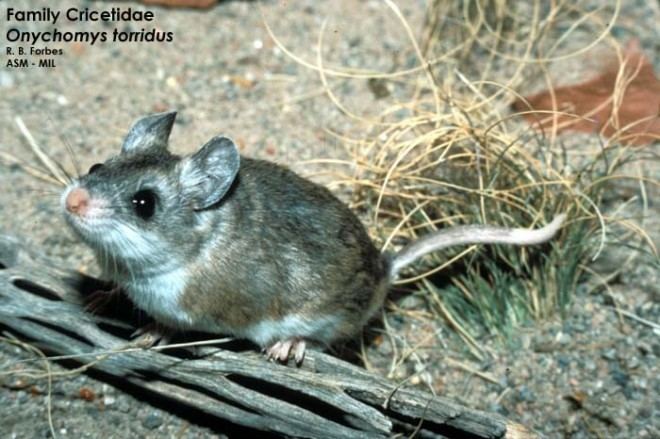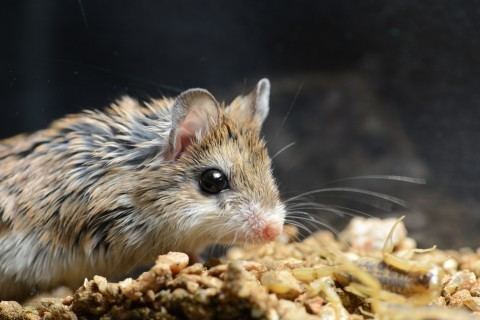Genus Onychomys Higher classification Grasshopper mouse | Phylum Chordata Scientific name Onychomys torridus Rank Species | |
 | ||
Similar Grasshopper mouse, Rodent, Mammal, Northern grasshopper mouse, Cactus mouse | ||
The southern grasshopper mouse or scorpion mouse (Onychomys torridus) is a species of the order Rodentia, and is in the family Cricetidae. It is found in Mexico and in Arizona, California, Nevada, New Mexico, and Utah in the United States. Notable for its resistance to venom, it routinely kills and eats Arizona bark scorpions, a species with a highly venomous sting.
Contents

Description
The southern grasshopper mouse is a robust, small, nocturnal species. They are usually known to be a monogamous species. They have a short tail, growing to a total length of 120 to 163 mm (4.7 to 6.4 in). The head, back and sides are pinkish- or grayish-brown while the underparts are white, the two colors being distinctly separated. The tail is club-shaped, short and broad, the anterior part being the same color as the body and the tip being white.
Biology
The southern grasshopper mouse feeds almost entirely on arthropods, such as beetles, grasshoppers and scorpions. Besides these, it preys on the little pocket mouse (Perognathus longimembris) and the western harvest mouse (Reithrodontomys megalotis).
In the arid regions inhabited by the southern grasshopper mouse, the Arizona bark scorpion is plentiful and avoided by most predators because of the very painful sting it can inflict. The grasshopper mouse can feed on this scorpion with impunity even when the scorpion stings it repeatedly in the face. Researchers have found that a neural mechanism is involved that blocks the sending of pain messages to the brain. This mouse can normally feel pain from other sources, but can be temporarily insensitive to these stimuli after a dose of venom from a bark scorpion.
Females are able to produce several litters in a year but their reproductive life is short, few breeding successfully in their second year. The average litter size is 2.6 (range 1 to 5), produced after an average gestation period of 29 days. The young are born naked, with pink translucent skin. One day later the pigment is developing on the dorsal surface and by day ten, hairs 3 millimetres (0.12 in) long are present on the back. The eyes open on day 15 and solid food is being consumed by day 19. The females give birth to their first litter when four or five months old.
Ecology
Southern grasshopper mice are unique among other North American rodents in the family Cricetidae in that their diet consists mostly of arthropods. They are usually found in areas with lower population densities. Several studies have demonstrated that the reproductive attributes of this species allows them to be naturally maintained at lower population densities. Females tend to be sexually active only during one breeding season, which is due to their rapid reproductive aging following their first year. Moreover, males' unique pauses in their testicular activity during the breeding season might also contribute to the lower population densities in which they live.
The natural habitat of southern grasshopper mice include hot, arid valleys, and scrub deserts. A male and female along with their offspring occupy a larger home range for burrowing compared to males and females alone. On average, males have a home range of 7.8 acres, while females occupy an area of 5.9 acres. They tend to maintain a specific place of residency for a longer period of time compared to other mammals. The home ranges between southern grasshopper mice are not too far from each other, with an average maximum distance of 118.4± 8.0 meters. However, adults males tend to be very territorial and their efficient spacing is facilitated by vocalizations they make at night.
In a study done by Denise H. Frank and Edward J. Heske, the home range of southern grasshopper mice in the Chihuahuan Desert were observed. They noticed that the home range of males during the non-breeding season was smaller compared to the home range of males during the breeding season. In contrast, there was not a significant difference between the home ranges of females during the breeding and non-breeding seasons. They also noted that the average home range of adult males was slightly greater, about two to three times bigger, compared to adult females during the reproductive season. Although this is a big difference, these results were also not very significant. The larger home range of males during the reproductive season might be a strategy they use to maximize the number of encounters they could have with potential female mates when trying to reproduce.
Furthermore, there are no currently known conservation issues associated with southern grasshopper mice, which is mainly due to its wide distribution and tolerance for disturbances caused by arthropods. However, some disturbances have been observed in their low density populations. Many more population studies will need to be performed in order to gain further insight into the conservation status of this species.
Predatory behavior
Southern grasshopper mice are a predatory, and very aggressive rodent species. In a study done by Richard McCarty and Charles H. Southwick, these grasshopper mice were deprived of food and their predatory behavior against laboratory mice and crickets was observed. After 48 hours of food deprivation, southern grasshopper mice spent more time eating crickets than the laboratory food they were provided. The crickets were both dead and alive, but they spent more time eating the unharmed living crickets, which might suggest that prey movement might be a catalyst and cue for predatory attack. The difference between the time that females and males spent eating living crickets was not significant, indicating that predatory attack is not necessarily more dominant in just one sex.
When southern grasshopper mice came in contact with laboratory mice of both sexes, they also showed very aggressive behaviors, such as biting the back and tail of their predator. After two days of being around the laboratory mice, six of the 43 male grasshopper mice and 22 of the 45 females grasshopper mice killed and ate certain parts of the laboratory mice. The difference between this aggressive behavior between the male and female grasshopper mice were significant. In their study, both McCarty and Southwick concluded that food deprivation and the type of prey affected the intensity and aggressiveness of the predatory attacks observed by southern grasshopper mice.
Brain and body size relation
Relative brain size tends to vary with food preferences. Brain size is usually smallest in folivores, larger in both granivores and insectivores, and largest in generalists. Measurements of cranial volume of museum specimens of southern grasshopper mouse have shown that on average, females were heavier and longer than males, but their cranial volume was about 3% less than that of males. However, this was not a significant difference. This pattern of brain-body relationship can also be seen in northern grasshopper mice. Moreover, the tail length of southern grasshopper mice made up an average of 33.9% of its body length. Their tail length measures an average of 4.58 ± 0.36 cm in females, and 4.50 ± 0.39 cm in males. Average tail length does not vary greatly between the sexes.
On average, female southern grasshopper mice are able to deal with a larger body size without increasing their brain size, when compared to males. There is still not enough evidence to explain the difference in body size and brain between males and females. It is possible that there are different demands on both sexes, which might contribute to this difference. These studies were also only done in the laboratory, and there might be sex-specific stresses in their natural habitat that influence brain growth. However, sexual dimorphism is quite common and has been observed in the central nervous system of other mammals.
